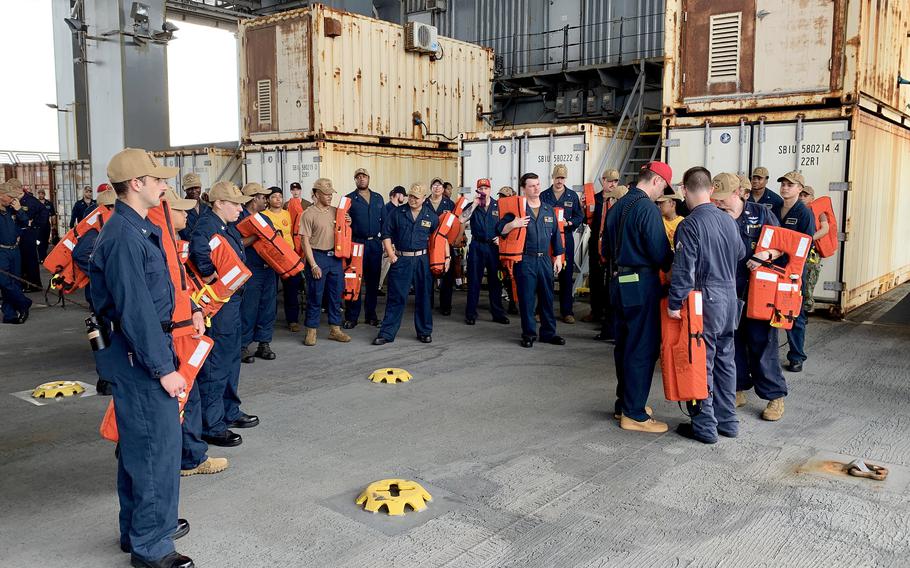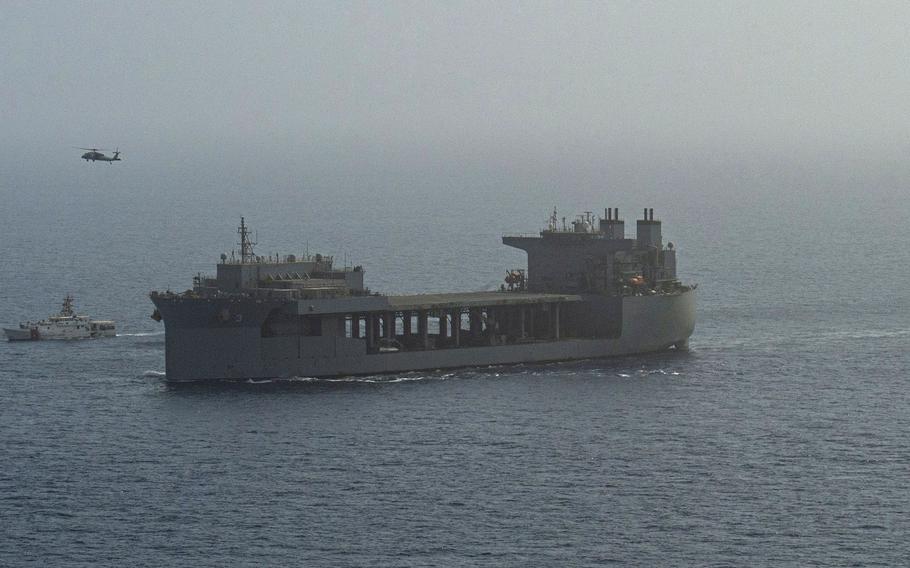
Sailors gather on the mission deck of the USS Hershel "Woody" Williams for an evacuation drill in May 2024 off the coast of Africa. The vessel is among the Navy ships that could see their operations reduced because of a severe shortage of civilian mariners. (Alison Bath/Stars and Stripes)
The Navy has sidelined 14 support ships as part of a broader plan to deal with a persistent civilian crew member shortage, according to the head of Military Sealift Command.
The plan “redistributes manpower to ensure our most critical ships are fully staffed and ready for mission demands,” Rear Adm. Philip Sobeck said in a message to the civilian mariner force last week.
Military Sealift Command operates about 125 vessels that replenish Navy ships, conduct special missions and preposition combat cargo around the world, among other tasks. There are more than 5,000 civilian mariner positions across the command.
MSC hopes to fill 95% of its jobs aboard ships at sea by September and keep vessels undergoing shipyard maintenance at 70% staffing as early as December, Sobeck said in his Feb. 6 message.
Officials also want to eliminate a backlog of mariners overdue for relief by more than seven days by September.
The service already has seen some success in reaching that goal, with the number of civilian mariners overdue for time off by more than 60 days reduced from 39 in August 2023 to 13 in January, Sobeck said.
The plan to address the manpower shortage was approved last year by former Secretary of the Navy Carlos Del Toro and Chief of Naval Operations Adm. Lisa Franchetti.
It’s unclear how many total ships could have their operations reduced. Command spokeswoman Jillian Morris said Tuesday that the number will fluctuate.
Replenishment oilers, cargo/ammunition ships and expeditionary fast transports are among selected vessels, the command said.

The expeditionary sea base USS Lewis B. Puller sails in the Gulf of Oman in July 2023. The ship could see its operations reduced as part of Navy efforts to solve a severe manpower shortage. (Elliot Schaudt/U.S. Navy)
The expeditionary sea bases USS Hershel “Woody” Williams and USS Lewis B. Puller, assigned to Africa and the Middle East, respectively, are ships that could see their operations pared down.
Rotating crews from those ships to higher-priority vessels will help minimize the number of personnel who are overdue for leave and training while offering a more predictable work schedule for civilian mariners, Morris said.
Over the past five years, the command has maintained a workforce of about 5,500 to 5,600 civilian mariners, but additional hires are needed to ensure adequate staffing, Morris said.
It wasn’t clear how many people MSC would hire to meet its goal.
Sobeck’s message follows reports in August that the Navy was reviewing a plan to sideline as many as 17 MSC ships to address a civilian mariner shortage that experts likened to a national crisis.
The plan was panned by some naval analysts, who said sidelining the ships could undermine U.S. efforts to check competitors in key theaters, such as Africa and the Middle East.
But they also conceded that the Navy’s options were limited in addressing recruitment and retention problems. Many civilian mariners leave the service, often for better pay and working conditions offered by commercial shipping companies.
In his message, Sobeck said the command’s retention recently improved to a level not seen in years.
The attrition rate in the first four months of the current fiscal year, which started in October, was 3.2%, compared with 5.6% over the same time in 2024. The overall attrition rate in 2024 was 14.6%, according to MSC.
By comparison, the attrition rate for the first four months of both 2020 and 2021 was 3.5%. The overall attrition rate for those years was 9.8% and 12.2%, respectively.
Those numbers could improve as civilian mariners see better work schedules and potential pay raises.
MSC recently began rolling out a rotational schedule that allows civilian mariners to work four months and take two months off, what Sobeck called “a monumental shift” that will improve work-life balance.
The command also is evaluating how to improve civilian mariner compensation but did not identify potential solutions under consideration.